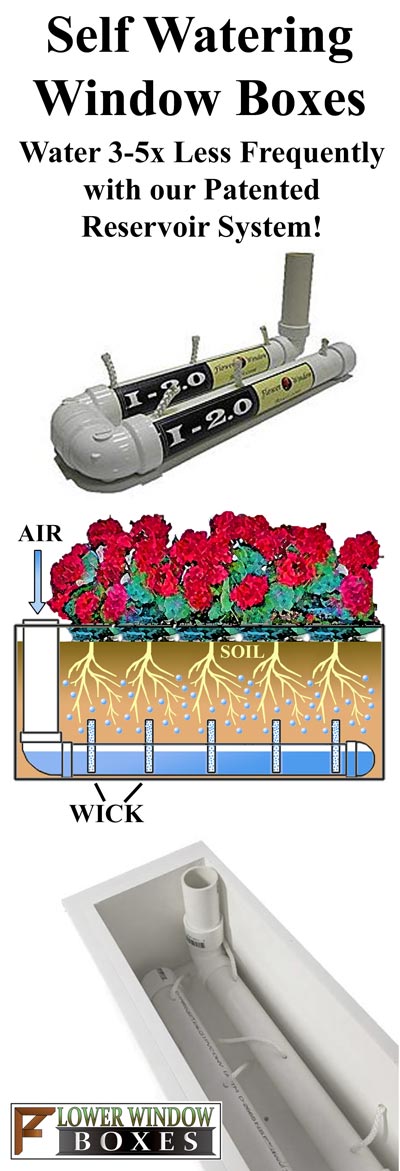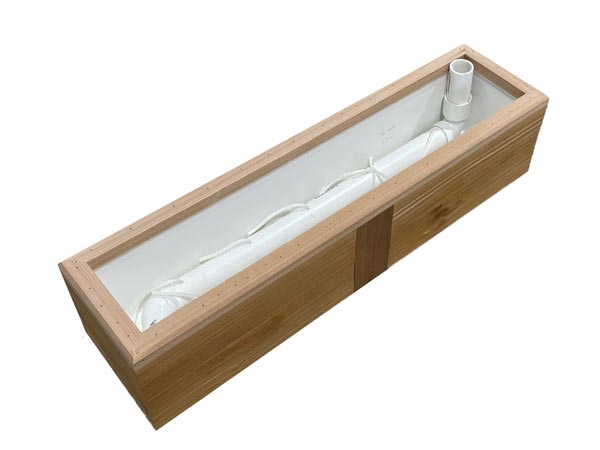
Types of Self Watering Window Boxes
Not all self watering window boxes use a window box water reservoir. Some work off the principle of a sprinkler line or drip irrigation line. Rather than the person having to manually fill the reservoir periodically, which still takes some maintenance, a drip line or irrigation line truly is set it and forget it. The majority of the maintenance comes in regular checks to make sure the box is still getting adequate water and that the lines have not diminished or stopped working. There may be some adjusting up or down depending on the seasons. Many self-watering systems work wonderfully in summer, however, you need to be careful during the winter that you follow the manufacturers directions as some water reservoir systems are not meant to be used in winter. The main disadvantage to winter is that water will freeze and expand during the colder months. This can cause a completely full reservoir to crack or fail and this can also cause a drip line to break resulting in the self-watering system no longer working. For warmer months this is usually not an issue. Indoor self-watering planters don't have to worry about these same issues as they tend to be regulated at room temperature, but more often than not a sub-irrigated reservoir system makes more sense than a sprinkler line or drip line which could potentially leak on the floor and cause damage to the house.
Why Use a Self-Watering Window Box System?
The main benefits of using a self-watering window box system is convenience. These systems require less frequent watering, so you don’t have to stress about watering your plants as often.
Similarly, when you’re far from home on vacation or a business trip, you don’t need to find someone to tend to your plants. Your plants also get more consistent watering by having a steady supply of water to promote healthy growth, and the self-watering window boxes ensure they never run out of moisture.
This is especially convenient when you forget to water your plants.
A self-watering window box system helps reduce water use as well and can help fight the forces of evaporation for a sun facing window box the always gets hot and the soil dries out. Self-watering systems help reduce water usage compared to traditional container gardening systems by allowing the water to reside deep inside the planter where it is less susceptible to this evaporation and closer to the root source. The moisture is delivered directly to the plant roots, saving you water that would’ve been wasted in the top soil.
Many self-watering systems work by allowing you to overfill or overwater your window box. This means that you may only have to water your window box once a week or once every few days instead of every day. This is very helpful if you have a busy lifestyle or if you go out of town and need a neighbor to tend to your plants while not having to ask them to water every day for you.

Pictured is the patented self-watering reservoir featured by Flower Window Boxes in all of their flower boxes. We have over 1000 styles, designs, and sizes of self-watering window boxes, planters, liners, and railing flower boxes.
What does SIP mean?
SIP stands for sub-irrigated planter. This can mean self-watering if there is a reservoir involved that retains extra water but not always. Some planters simply get normal watering from below. Many pots and square shaped planters can be converted into sub-irrigated planters, as well as self-watering planters, by using a simple stacked bucket system and some fabric.
How to Make a DIY Sub-Irrigation Planter
To make an easy beginner SIP you can use the following materials:
• 2 five gallon empty buckets
• 8" long Wicking material (a rope or fabric)
• Drill
• 1/4" drill bit and 2" hole cutter bit
• 2 ft length of 2" diameter PVC Pipe
• PVC Pipe
Step-by-Step to Install a Self-Watering System
1. Drill several 1/4" holes at the bottom of the first bucket.
2. Place this bucket with holes into the other bucket. There will be a 3-4" hollow space now between the buckets where excess water can reside. This is your reservoir space.
3. Insert the wicking material through each of the holes and stuff about 4" of the material into each hole. Leave 4" hanging out and above the inner bucket.
4. Using a 2" hole cutting bit to drill a 2" hole on the edge of the inner bucket. Then place the 2" diameter PVC pipe in this hole so that one end goes into the reservoir and the other end sticks out the top of the buckets.
5. Fill the top bucket with soil and plant your desired plants and flowers covering up the pipe and wicks. When you are done just the top of the PVC pipe will be visible and this is where you will pour water down the pipe to fill up your bottom chamber between the buckets.
Tips for Maintaining a Self-Watering System
The following tips will help you get the most out of your self-watering window boxes:
• Monitor the water levels in your reservoir regularly and refill it when needed.
• Check the moisture levels in the soil and adjust the water level in the reservoir accordingly.
• Consider the type of plants in your window box because some may need more water than others.
 About the Author About the Author
Matthew Buquoi is the owner of Flower Window Boxes, Inc., which is one of the largest online window box companies in the United States. In addition to being the owner, he is also an expert author, and regularly writes about industry topics in the window boxes, planters, exterior shutters, and home and garden industry.
|
|
|